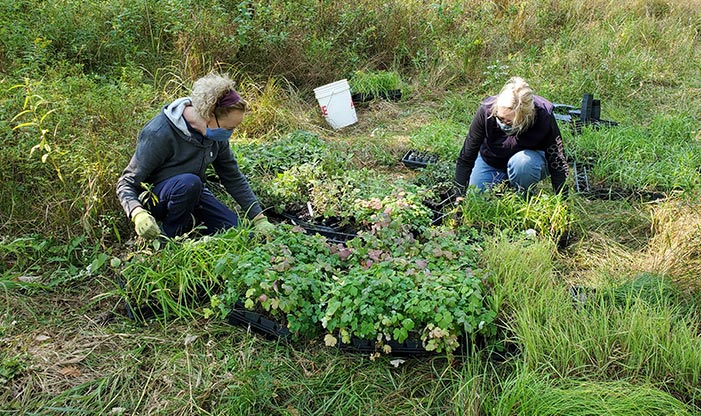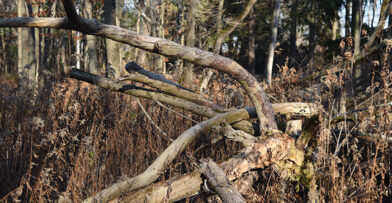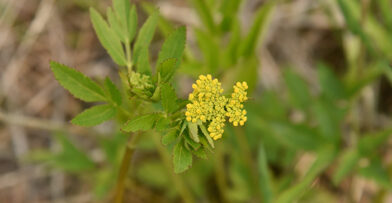A rare habitat type called southern hardwood swamp is being restored in what was once a degraded corner of the Center, thanks to a grant from the U.S. Fish and Wildlife Service and hundreds of hardworking volunteers. Uncommon in this region even prior to European settlement, today it is estimated that less than 1% of southeastern Wisconsin could be classified as this habitat type.
According to Wisconsin Department of Natural Resources, southern hardwood swamps are characterized by their seasonally high water tables that usually dry out by late summer, and are located in basins not associated with major rivers. They also tend to have a higher component of plant species that prefer these hydrologic conditions. Our four-acre hardwood swamp project area fits this description perfectly and is an ideal location to restore this diverse wetland community.
Species Affected by the Restoration
Part of Schlitz Audubon’s Conservation Plan is to conserve and restore wildlife populations of greatest conservation need, and as a rare habitat type southern hardwood swamp performs a very important ecological role. The restored understory will support many pollinator species, including rusty patched bumble bee and monarch butterfly, and provide food, cover and breeding habitat for migratory birds, including Pine Warbler, Wood Thrush, American Woodcock, and Northern Flicker. The increased hydroperiod of the swamp will also provide essential spring stopover habitat for Canada Warbler, Blue-winged Teal, Wood Duck, and many additional species of greatest conservation need.
Located between Brown Deer Road and the West Meadows loop, for many years most visitors would likely have overlooked this area. The Center used to be a working farm, and an old agricultural drainage ditch still bisects this area. Colonization by highly invasive reed canary grass and the loss of three ash species due to emerald ash borer make restoration in this area regionally significant.
Managing the Restoration
For many years, Schlitz Audubon staff and volunteer land stewards have been removing invasive shrubs and herbaceous species and felling hazardous ash. When the U.S. Fish and Wildlife Service agreed to help fund restoration, an extensive planting plan was established to begin this fall.
So far this year, volunteers and staff have planted 2,632 herbaceous plugs. Among those planted is a wide variety of native wildflowers, including wild bergamot, wild columbine, and black-eyed Susan. In addition to meeting the Center’s conservation goals, these flowers will provide a splash of color for those looking in from Brown Deer Road.
The Next Phase of the Project
In the next few weeks, volunteers and staff with be planting 715 trees to replace the dying ash canopy with in the project area. Important tree species include swamp white oak, bur oak, hackberry, and sycamore. These trees will provide food and cover for migrating and canopy nesting birds and provide leaf litter used as overwintering habitat for several bumblebee species.
In addition to the trees, our hardworking team will plant 250 shrubs, including silky dogwood, winterberry, elderberry, and nannyberry. By supplementing the low cover currently in the area, these plantings will help establish the desired 10% shrub cover that is typical of hardwood swamps. Shrubs provide nesting habitat, cover and food for many bird species, as well as vital spring flowers for pollinator foraging.
Experiencing the Hardwood Swamp
The best way to experience the project area is to volunteer! More planting is slated to occur in spring 2021, when staff and volunteers will plant 24,500 herbaceous plugs in the project area. This will require an enormous effort, and the Center welcomes groups and individuals to get involved. If interested, contact our Volunteer Coordinator at (414) 352-2880 x144 or volunteer@schlitzaudubon.org.


